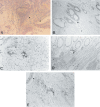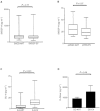Arterio-venous gradients of IL-6, plasma and serum VEGF and D-dimers in human cancer
- PMID: 12454774
- PMCID: PMC2376277
- DOI: 10.1038/sj.bjc.6600655
Arterio-venous gradients of IL-6, plasma and serum VEGF and D-dimers in human cancer
Abstract
The circulating angiogenic factors vascular endothelial growth factor-A, interleukin-6 and the fibrin D-dimer fragment were measured in the mesenteric vein, the uterine vein, as well as in peripheral venous and arterial samples in 21 randomly selected patients with operable colorectal, ovarian and cervical carcinoma. In addition, immunohistochemistry for vascular endothelial growth factor-A and interleukin-6 was performed on colorectal tumours of such patients. Serum and plasma vascular endothelial growth factor-A were not significantly elevated in the vein draining the tumours, despite tumour cell expression of vascular endothelial growth factor-A. Serum vascular endothelial growth factor-A is therefore not all tumour-derived. In contrast, serum interleukin-6 was highly elevated in the draining veins in agreement with expression of interleukin-6 in the cytoplasm of tumour cells. In the megakaryoblastic cell line MEG-01, the expression of vascular endothelial growth factor-A was found to be regulated by interleukin-6. Thus, the higher platelet vascular endothelial growth factor-A load resulting in higher serum vascular endothelial growth factor levels in cancer patients may partly result from an interleukin-6 mediated up-regulation of the expression of vascular endothelial growth factor-A in the precursor of the platelet, i.e. the megakaryocyte. We also confirmed by immunohistochemistry that platelets adhere and aggregate on tumour endothelium. We propose that interleukin-6 indirectly promotes tumour angiogenesis through its up-regulation of the vascular endothelial growth factor-A load in platelets. In addition, the correlations found between peripheral venous interleukin-6 and peripheral venous fibrinogen and D-dimers levels, and the high D-dimer levels found in the draining vein of the tumour, in agreement with fibrin deposits found in the tumour stroma, suggest an important role for interleukin-6 in extra-vascular fibrinogen metabolism. Our results suggest a pivotal role for interleukin-6 in the intrinsic link between haemostasis and angiogenesis. This might be of importance in the development of anti-angiogenic agents based on interference with haemostasis.
Copyright 2002 Cancer Research UK
Figures




Similar articles
-
Plasma fibrin D-dimer levels correlate with tumour volume, progression rate and survival in patients with metastatic breast cancer.Br J Cancer. 2002 Feb 1;86(3):389-95. doi: 10.1038/sj.bjc.6600069. Br J Cancer. 2002. PMID: 11875705 Free PMC article.
-
Clinical significance of preoperative serum vascular endothelial growth factor, interleukin-6, and C-reactive protein level in colorectal cancer.BMC Cancer. 2010 May 14;10:203. doi: 10.1186/1471-2407-10-203. BMC Cancer. 2010. PMID: 20465852 Free PMC article.
-
Serum basic fibroblast growth factor and vascular endothelial growth factor and tumour growth kinetics in advanced colorectal cancer.Ann Oncol. 1996 Oct;7(8):843-8. doi: 10.1093/oxfordjournals.annonc.a010764. Ann Oncol. 1996. PMID: 8922199
-
Biomarkers of anti-angiogenic therapy in metastatic colorectal cancer (mCRC): original data and review of the literature.Z Gastroenterol. 2011 Oct;49(10):1398-406. doi: 10.1055/s-0031-1281752. Epub 2011 Sep 30. Z Gastroenterol. 2011. PMID: 21964893 Review.
-
[Tumor makrers in cervical cancer].Ginekol Pol. 2007 Sep;78(9):715-8. Ginekol Pol. 2007. PMID: 18159826 Review. Polish.
Cited by
-
A review of research progress on mechanisms of peritoneal fibrosis related to peritoneal dialysis.Front Physiol. 2023 Sep 25;14:1220450. doi: 10.3389/fphys.2023.1220450. eCollection 2023. Front Physiol. 2023. PMID: 37817984 Free PMC article. Review.
-
Coagulation/fibrinolysis and circulating tumor cells in patients with advanced breast cancer.Breast Cancer Res Treat. 2022 Apr;192(3):583-591. doi: 10.1007/s10549-021-06484-1. Epub 2022 Feb 8. Breast Cancer Res Treat. 2022. PMID: 35132503 Free PMC article.
-
Prognostic value of serum levels of interleukin 6 and of serum and plasma levels of vascular endothelial growth factor in hormone-refractory metastatic breast cancer patients.Br J Cancer. 2003 Jun 2;88(11):1721-6. doi: 10.1038/sj.bjc.6600956. Br J Cancer. 2003. PMID: 12771987 Free PMC article.
-
Anti-angiogenic therapy in ovarian cancer: Current understandings and prospects of precision medicine.Front Pharmacol. 2023 Mar 7;14:1147717. doi: 10.3389/fphar.2023.1147717. eCollection 2023. Front Pharmacol. 2023. PMID: 36959862 Free PMC article. Review.
-
Activation and coagulation biomarkers are independent predictors of the development of opportunistic disease in patients with HIV infection.J Infect Dis. 2009 Sep 15;200(6):973-83. doi: 10.1086/605447. J Infect Dis. 2009. PMID: 19678756 Free PMC article. Clinical Trial.
References
-
- BenoyISalgadoRColpaertCWeytjensRVermeulenPBDirixLY2002Serum interleukin 6, plasma VEGF, serum VEGF, and VEGF platelet load in breast cancer patients Clin Breast Cancer 2311315 - PubMed
-
- BobikRHongYBreierGMartinJFErusalimskyJD1998Thrombopoietin stimulates VEGF release from c-Mpl-expressing cell lines and haematopoietic progenitors FEBS Lett 4231014 - PubMed
-
- BordenECChinP1994Interleukin-6: a cytokine with potential diagnostic and therapeutic roles J Lab Clin Med 123824829 - PubMed
-
- CarmelietPCollenD1998Development and disease in proteinase-deficient mice: role of the plasminogen, matrix metalloproteinase and coagulation system Thromb Res 91255285 - PubMed

